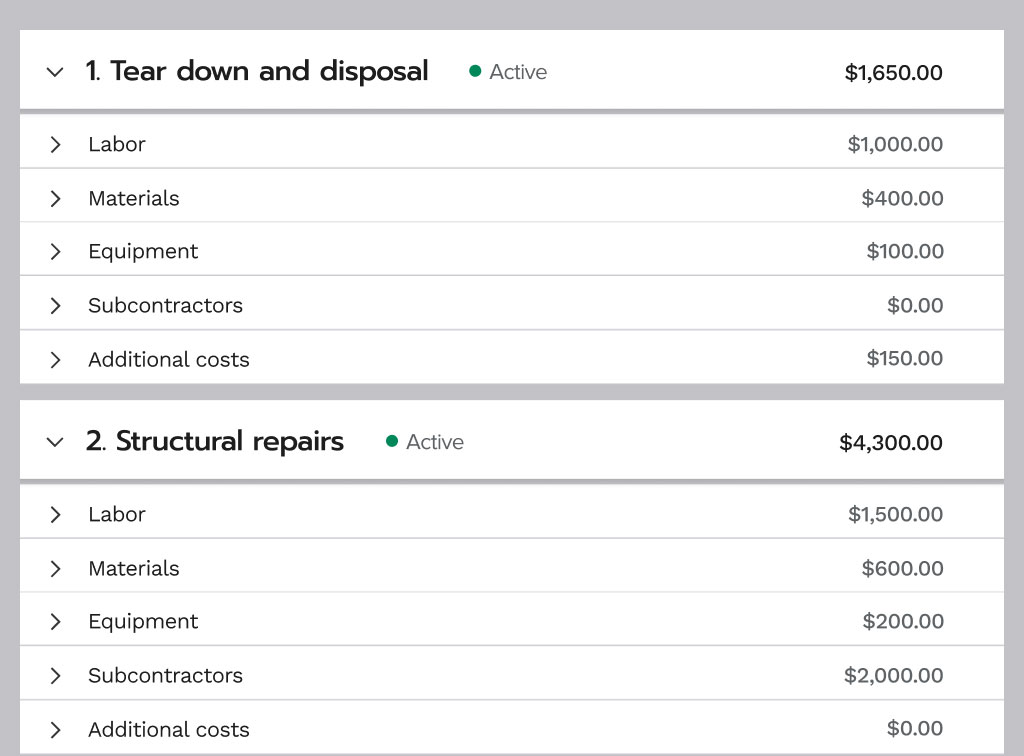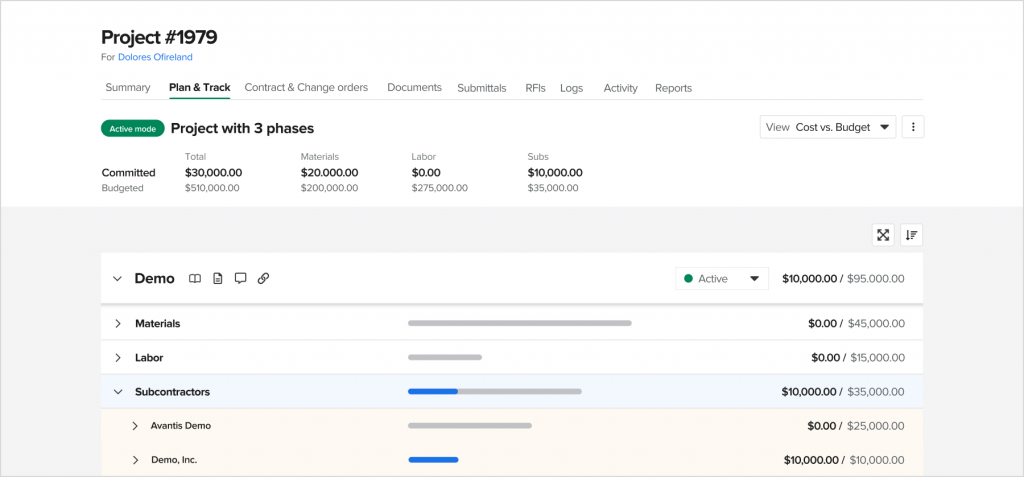As material and labor costs continue to rise, construction contractors are left wondering– are my jobs priced right? Answering that question, however, can be challenging; pricing is a delicate balance between charging enough to stay profitable without chasing away potential customers with exorbitant prices. To find the sweet spot between fair and profitable, contractors must develop the ability to craft accurate job quotes.
A quote is a detailed breakdown of a construction project’s major expected costs, including markup. This breakdown generates a price that a contractor needs in payment to complete a job. But before a quote can be generated and sent to clients, contractors must price their jobs appropriately. After all, if you don’t get paid enough to make a profit, all of your hard work will be for naught.
This article will give contractors everything they need to know to properly price jobs to ensure they cover job costs and make a reasonable profit. Additionally, we’ll discuss best practices that you can use to create a job quote that is attractive to potential customers yet profitable enough to ensure your business continues to grow.
How to price a job in construction
Profit is not something that should be left up to chance. It can and should be calculated. When you know your numbers, you know the exact steps you need to take to make money on every job. To determine how to price a construction job, there are two fundamental formulas:
- Price = Cost x Markup
- Net profit = Income – Cost of goods sold – Expenses
The cost of goods sold as it relates to the construction industry are any direct costs that go towards the execution of a job; typically, this equates to the cost of labor, materials, equipment, and subcontractors costs. In addition, expenses will include any additional costs that do not fall into the above major cost categories.
Before sitting down with these calculations, it’s important to tackle every job with a goal. Setting financial goals is paramount for any business owner to not only make business operations profitable but to ensure you have enough cash coming in to support you and your family. Our next step will explore how to set such a goal to ensure you are fairly compensated.
Include your salary as a business owner
For a general rule of thumb, a contractor should aim for a salary of $60,000 or more as pay for owning and running a company. Remember the risk, hard work, effort, and determination that go into running a business. For all these reasons, you, as the business owner, should always be the highest-paid person in your company. If you’re not quite at the $60,000 salary range yet, don’t worry. As you focus on profitability and improving efficiency, your business will inevitably grow, and your personal income with it. All that being said, how exactly does this relate to pricing construction jobs? Because determining a salary goal will help calculate the overall sales volumes needed to support your salary. This, in turn, will reveal a foundational financial goal to help determine how much is needed to remain financially stable.
If your salary goal is $60,000, divide that by .08. This number will give you an appropriate sales volume to support that goal, with you–as the owner–taking 8% of all sales as payment. So for a salary of $60,000, a sales volume of $750,000 will be required to adequately support your salary. Then, as your business grows in scale and profitability remains stable, you can increase your take home to 9% or 10%+.
This overall sales volume number should now serve as a financial goal for your business. This should be kept top of mind when managing every aspect of your business. Use it as the basis for pricing jobs, managing cash flow, bidding strategy, and overall business decisions, as this sales number is required to keep you in good financial standing.
Estimating project costs
The next step in determining price will include estimating the project’s major job costs. This is best done by breaking the job into phases or stages with cost estimates for each phase. For example:

Successful pricing relies on starting with an accurate project estimate. It’s critical that you nail down a formal estimating process. Standardizing your process for creating estimates also you to fine tune it far more effectively than if you just fly the seat of your pants for every job. A great place to start is by reviewing past job cost reports. Look at the actual (not budgeted) costs for similar jobs and use those values as a starting point.
Estimating labor costs will need to start with breaking out costs per employee per hour. Another crucial component of labor costing is labor burden. Labor burden is all of the costs outside of wages that it costs a business to employ an individual. This includes workers comp, taxes, benefits, and more. Not including labor burden can cost a business thousands of dollars on every job. If you need help calculating labor costs see our labor costing in construction article for an in-depth explanation.
Material costs will fluctuate depending on the size and type of job. Therefore, it’s not advised to generalize material costs across all jobs, so it’s vital to crunch the numbers for every job to ensure you are staying as accurate as possible. For more help calculating and tracking all major job costs check out our essential guide to construction job costing to learn everything you need to know to job cost professionally for enhanced profitability on every job. Once all costs have been estimated for the entire project, that number can be used to calculate markup and price.
Determine a desired markup and margin
Whether you are a specialty contractor, general contractor, primarily work in commercial or residential, the same basic principle applies across the board. Every construction business owner must charge enough to cover job costs, pay employees, pay overhead expenses, and make a reasonable profit to keep the business running.
First, let’s take a moment to clarify the difference between markup and margin. At a simplified level, profit margin is what determines the amount you keep–derived from sales–while markup determines the amount you charge the client–determined by job costs. You’ll need to know your projected annual sales volume to calculate markup. Projected annual sales should be realistic yet ambitious enough to cover costs and make a reasonable profit. This number is partially calculated through your earlier financial goal of earning 8% of total sales.
After determining annual sales, contractors must determine job costs (which we discussed in the previous section). As a reminder, these will include labor, material, equipment, subcontractor fees, and additional expenses for the job. With job costs and an annual sales number in mind, contractors can work to determine a markup that works for them.
- Markup = ( Price – Cost ) / Cost
For help determining profit margin, a good place to start is to find a breakeven margin percentage.
- Breakeven margin = Annual overhead expense / Estimated annual sales
For example, let’s assume a framing contractor has $150,000 in overhead expenses and estimates that annual sales will equal $800,000. From here, the formula would reflect the following:
- 150,000 / 800,000 = .1875
Rounding up to 19% will give a breakeven margin to meet basic costs, given your overhead expenses. This should serve as the foundation for developing a profit margin that accounts for variable job costs.
To do this, you must take the expected revenue for the job, subtract costs, and then divide that number by projected revenue. Then take that number and multiply it by 100 to find your percentage.
- $30,000 (revenue) – 16,000 (job costs) / 30,000 = .466— .466 x 100 = 47%
Accuracy is crucial here. Make sure that you take the time to know your numbers and calculate figures that make sense for your business. Once you have identified a desired markup percentage and margin percentage, you can use a margin & markup table to find an appropriate markup multiplier that you’ll use to determine a fair and accurate price. For example, the national construction industry average for markup falls between 1.54 – 1.67. But how do you go from a tried and true margin percentage to an appropriate markup that will cover costs and result in a healthy profit? In the following section, we will look at how to bring all of this information together to arrive at an accurate price.
Choose a pricing method
Cost-based
Take the total estimated job costs and multiply that number by a markup factor. How do you find your markup factor? For example, if your markup percentage is 50%, then your markup factor is 1.5, which will then be plugged into the following formula:
- $50,000 total job cost x 1.5 = $75,000 price for job
The important thing to remember for this method is to be painstakingly accurate with your cost estimates; don’t guess. Do the hard work to estimate your costs as accurately and detailed as possible.
Price-based
The next method will assume that you know the amount you want the price of a job to be, but you aren’t sure if it’s enough to cover costs and generate a profit. The basic formula for this pricing method is as follows:
- Price / Markup factor = Costs
Taking the same markup factor of 1.5, let’s assume that a contractor wants to charge $30,000 for a project. The calculation would look like this:
- 30,000 / 1.5 = $20,000 project costs
This number of $20,000 now essentially works as a budget for this project. It tells the contractor that the project cannot exceed $20,000 if they want to hit financial goals for the job. However, it’s still on the contractor to calculate their own numbers to ensure it’s feasible to perform the job under those financial restraints. If this same contractor estimates that it will actually cost $23,500 to perform the job, they can multiply this cost number by their markup factor to arrive at a new price as we did with the cost-based method for pricing.
- 23,500 x 1.5 = $35,250 price for the job
Without running through this exercise, the contractor would have had no way of knowing how much to spend or charge to secure a profit. Whatever the case, contractors must ensure they are calculating accurate job cost numbers. With a detailed cost estimate, the appropriate amount of markup can be applied to arrive at a new final price to ensure profitability.
Margin-based
The next method will look at how to price a job based on a desired margin. With this method, the basic formula will reflect the following:
- Price = Job costs / (1 – Desired margin)
If a contractor has determined that job costs will equal $25,000 and the desired margin is 46%, the calculation will reflect the following:
- $25,000 / (1 – .46) = $46,296.29 price for the job
No matter what method is chosen, as we have discussed, knowing your cost numbers inside and out is central to arriving at a fair and profitable price.
See how Knowify helps contractors get accurate, budget-backed bids out in minutes
Pricing best practices
Understand the scope of work
Taking the time to thoroughly comprehend the scope of work is a pivotal step contractors can take to price jobs effectively. A scope of work will include key pieces of information, such as objectives, deliverables, schedules, and requirements. All combined, this provides needed insight into factors that will impact cost and timelines for contractors. Assessing the scope of work will also provide an opportunity to talk to the project owner to discuss the location, evaluate site conditions, and hammer out additional details. Again this is vital to accurately estimate costs.
Price fairly & intentionally
General business best practices apply here. Don’t undersell your services to gain more business; don’t excessively overcharge to take advantage of your customers’ hard-earned dollars. However, determining a desired profit margin and markup will be a significant decision for overall business operations as it will determine where your prices stand compared to other contractors.
This is the idea behind premium pricing vs. economy pricing. A premium pricing strategy means higher prices, but a lower sales volume is needed to hit profitability goals. If you take the opposite approach and lower prices, you may get more jobs, but the sales volume needed to sustain your financial stability will increase dramatically. Choose your approach carefully.
Review past job costing data
Understanding past performance on jobs is critical to pricing jobs. Take the time to review past jobs that are similar in size and scope to the job you are trying to price. This will provide valuable insight into where costs eventually went, where you overspent or underspent, and any unforeseen costs you may be able to catch this time. This requires a comprehensive job costing system that can present relevant information in a digestible and actionable way. We’ve written quite a bit about how you can get the most out of your job costing system to make profitable decisions.
Use construction management software
Using the right tools can make all the difference for contractors looking to improve their financial standing. Software will allow cost data to be securely stored and tracked. This enables accurate cost estimates and job costing, as labor, materials, equipment, and subcontractor costs can be easily tracked to give contractors the necessary information to accurately estimate job costs before sending bids.
How Knowify helps pricing construction jobs profitably

Knowify brings a set of features that are specifically designed to help specialty contractors enhance profitability. Through our intuitive software, contractors can manage sales pipelines from beginning to end with accurate estimating and detailed tracking of major job costs. This gives contractors immediate access to the information they need to price jobs properly and then track those jobs to ensure they stay on the right track.
After completing a job, Knowify delivers crucial insight through a powerful reporting system displaying profit and revenue information that can be used to take immediate action. Through customizable templates that can be used to create fast and accurate estimates, Knowify offers a range of features to help contractors price jobs fairly, accurately, and profitably.
Sending the quote
Once contractors have worked out a price that is right for their business goals, Knowify will help deliver a robust quoting system for fast, accurate quotes. We start by providing a streamlined process that brings together all necessary information. Every detail of the job, including the scope of work, estimated hours, contract information, catalog systems, and previous quotes, are easily accessible. From here, simply input the price for each item or service included in the quote. When it’s time to send it off, utilize a paperless process through e-signatures and a seamless client portal for enhanced professionalism. After sending the quote, Knowify makes it simple to follow up with the client to ensure they received it and to answer any questions all within the same platform.
Set the right price & win more bids
Meet with a Knowify expert today to see how you can start building winning bids faster with Knowify.
